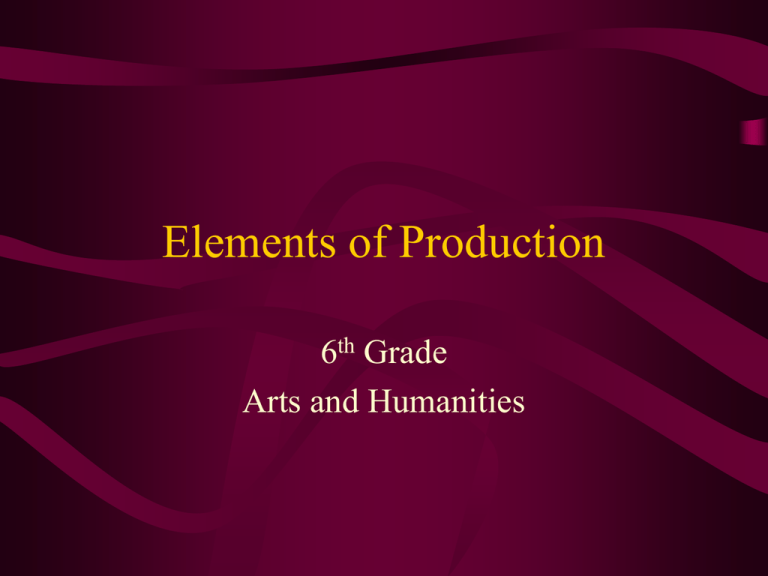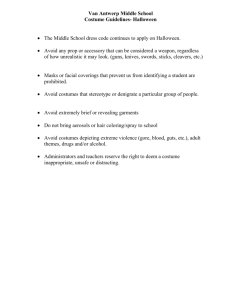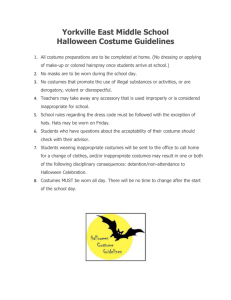Elements of Production
advertisement

Elements of Production 6th Grade Arts and Humanities Elements of Production • • • • • • • Lighting Stage types and directions Sound Scenery Make-up Costumes Props Lighting • • • • Enhance Visibility Increase Realism Highlight Costumes, Make-up, and Scenery Contribute to the Composition and Design of the Stage Environment Sound • • • • Greatly enhances theatrical performance Sound conveyed to the audience Sound Effects Music Scenery • • • • Set Curtain Sets Box Sets Screen Sets/Flats Props • Any object used for a performance • Hand props: anything carried on-stage by an actor during a performance. -Weapons, tools, food, cane, purse, skateboard, basketball, football • Set Props: Anything used on-stage during a performance. • -Go-cart, dirt-bike, couch, bed, toaster, television, refrigerator, plant, table • Personal/costume Props: Anything worn by a character/actor during a performance. -sunglasses, jewelry, watch Make-up: 2 types • Character Make-up • Straight Make-up Makeup • 1.Color or lines applied to the face and features of an actor to aid in creating a character. 2. Completes costume 3. Enriches Characterization 4.Gives a psychological boost to the actor Costumes enhance the meaning and mood of a play and to help define the characters. • • • • Tell Setting of the Play Tell Social Rank of Character Convey Mood Provide Character Information Why a Modern Actor Needs Makeup: 1. Stage lighting washes out the faces of actors on stage. 2. Makeup defines their features 3. Audience needs to see the actors’ facial expressions 4. Gives information about character a. Health b. Age c. Character Character Makeup 1.Makeup that changes the appearance of an actor into that of the character being portrayed. 2.Includes items that drastically change an actor’s appearance. Straight Make-up: 1.Makeup that enhances the features of the actor without changing his or her appearance. 2.Used when an actor plays a part that does not require a change in appearance. How to Apply Makeup 1. Foundation: makeup that is close to your natural skin tone that you will use to cover your face, neck, and other exposed areas. a. Greasepaint: oil based stage makeup b. Pancake Makeup: Water based makeup 1. Color of foundation is chosen by your natural skin tone or by the character. Shadows and Highlights: a. Help to create the character you are playing or enhance your natural contours. b. Dark colors recede and light colors advance Eye makeup a. Eyes show emotion and should be visible to the audience b. Eye makeup calls attention to your eyes and visually enlarges them. c. Eye shadow should be close to the color of your skin unless there is a good reason to do otherwise d. Shape of eyebrows shows character. Rouge a. Adds color and contours to the actor’s face. b. Can impart a healthy glow Powder and Lipstick 1. Powder a. Helps set makeup and remove the shine caused by greasepaint. b. Use a powder that is lighter than foundation or colorless 2. Lipstick:The shape and expression of the mouth help to show character, so lipstick can help you create a believable character. Guidelines for applying makeup 1. Strive to look natural by not using too much makeup 2. Have a good reason for whatever makeup choices you make. 3. Work with your facial features 4. Focus on shadows and highlights rather than lines 5. Follow the bone structure of your face 6. Practice applying your makeup for a part before opening night Costumes: Setting of a Play 1. Costumes help the audience know the setting of a play. 2. Setting: the time and place of a play. 3. Period Play: a play set in a particular historical period with the speech patterns, manners, and costumes of that time. 4. Costume Silhouettes: the outline of a costume worn by an actor on stage. Costumes: Social Rank of Character • Costumes can reveal the social rank or economic status of a character in a play. Costumes: Convey mood I • Color and Costume • 1. Color on stage helps to establish the mood of the play. • 2. Dark or dull colors lend a feeling of seriousness, sadness, even depression. • 3. Lighter, brighter colors lift the spirits and show a less serious mood. • 4. Color in costuming also affects the way the audience perceives the action on stage. • a. Important characters set apart by bright colors Costumes: Convey mood II • 5. Color of a costume is also important in increasing the depth of a character. • a. Dynamic, expressive characters may wear vivid colors • b. Meek or weak characters wear pale colors • 6. Colors can distinguish characterization for actors and audience. • 7. Characterization: Putting the particular facets of a character together to make a believable person on stage. Wearing a Costume Comfortably on Stage: • Movement is the key to acting, so the actor must not let wearing a costume interfere with movement on stage. A. Costumes that are different from the type of clothing one normally wears can make stage movement difficult. B. Tips for wearing costumes on stage. Wear your costume as much as possible before the performance. 2. Learn to walk, stand, sit, and bend naturally and comfortably in your costume. 3. Do not forget to practice wearing all the details of your costume, such as boots, gloves, wig, glasses, and mustache. 4. Be familiar with all of your character’s costumes. 5. Familiarize yourself with all accessories. Stage Types • Proscenium (Conventional) • Arena • Thrust Proscenium • • • • Picture frame view Audience on one side Backstage Wings Thrust • • • • Combines features of Thrust and Arena Audience on Three Sides Backstage No wings Arena • • • • Sometimes called “Theater in the Round” Surrounded by Audience More audience participation Challenging for moving props and scenery Stage Directions • • • • • • • • • • • • Center Stage Off stage left Off stage right Backstage Upstage Right Upstage Center Upstage Left Centerstage right Centerstage left Downstage right Downstage center Downstage left




